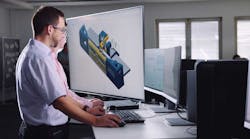The manufacturing industry and machine builders face the challenge of progressively more complex machine introductions. Digitalization is proving to be critical to addressing compressed schedules with advancing technologies and global competition. It is a key enabler to meeting shorter delivery timeframes with advancing technology and global competition.
One such technology is Digital Part Production (DPP) from Siemens, which provides a fully connected digital thread, allowing both the digital and physical worlds to merge. This dynamic creates a continuous digitalized communication and feedback loop to help machine builders understand how updates to a part’s design impact the more extensive manufacturing process.
There is a need for an integrated digitalization solution to drive through the whole manufacturing process. Based on a comprehensive digital twin, this approach enables machine builders to master the precision of the perfect part while offering greater operational efficiencies and the ability to manage their shop floor better. In other words, DPP offers new engineering and manufacturing practices to keep pace with this growing complexity, driving the highest possible production throughput and quality part production. It connects the entire production process digitally, improving the collaboration and automating many processes between engineering and manufacturing on the shop floor.
This method automates the entire part production development based on a comprehensive digital twin of the product combined with a digital twin of the production that optimizes resources, controls and production cost while achieving the highest quality. These digital twins allow companies to simulate design and manufacturing even before fixtures have been built and materials are cut. Now it is possible to connect the entire production operation, cut data transfers and duplication, improve collaboration and automate all processes.
To achieve this, DPP possesses three key differentiators that help master the precision to create the perfect part:
- Highly automated CAM allows the re-use of proven data to automate programming and optimize machining processes to deliver consistent results, improving quality and reducing time to market.
- Synchronized part manufacturing increases operational efficiency by using one integrated system to design, simulate and machine parts.
- Additive manufacturing allows the creation of complex geometries that are difficult or impossible to achieve with traditional manufacturing methods. In addition, these complex geometries are often more robust and lighter than their traditionally manufactured counterparts.
Leading companies are discovering that the future of Digital Part Production lies in adopting new software tools to connect various applications and processes by using a comprehensive digital twin. DPP connects the entire production process, cutting data transfer rate duplication, improving collaboration, and automating the engineering and manufacturing processes.
More importantly, DPP incorporates information-sharing feedback loops throughout the organization, continuously improving and becoming more streamlined.
Automated CAM Enhances Part Quality
Machine builders and suppliers can stay competitive in today’s global market by adopting highly automated CAM to efficiently create exceptional quality components. It links engineering to manufacturing planning and execution, merging the digital and physical processes by uniting an accurate digital twin of the part with a precise digital twin of the machining process, all connected by a digital thread that combines the entire production process. Subsequently, previously siloed teams are entirely aligned, accessing the same up-to-date information, helping teams deliver a 30% to 40% improvement in overall efficiency and delivering top-quality products faster to the customer.
Integrating CAD, CAM and CNC tools cuts data transfers and duplication, automates shop floor processes, and reduces the risk of costly and time-consuming errors. It relies on feature-based machining that uses PMI that is captured during the design’s 3D modeling phase to automatically program and optimize machining methods, thus boosting quality and efficiencies. The system analyzes the part, finds the features, picks the right cutting tools and creates the complete machining processes to save time and deliver consistent quality across the machined parts.
Another crucial element of highly automated CAM is deploying a digital twin of the machine setup to virtually optimize and validate the machining process. This attribute assists in avoiding costly errors in production, effectively eliminating waste on the shop floor. The digital thread connects the systems, machines and people to automate the entire end-to-end process—from design and simulation to machining and system assembly, reducing manual interaction and minimizing mistakes.
Synchronized Part Production Improves Efficiency
When introducing complex variations into a product supply chain, it is necessary to synchronize the component part production to minimize inventory and costs. By digitally connecting the entire production process, machine builders can meet a customers’ schedule, cost and quality demands.
Synchronizing customer-configured component part production enables a flexible, transparent, data-driven decision-making process. It offers one environment for seamlessly integrated part preparation, programming, scheduling and production, thus improving collaboration across the machine builder’s organization. A comprehensive digital twin makes synchronization possible—a 3D model that simulates the machine’s parts. Stakeholders can now see how each change to the part design impacts the complete manufacturing process, while changes made to the model automatically update in the CAM. Similarly, it also allows design engineers to use manufacturing information for the design early in the engineering process.
Synchronizing the part production fast tracks the time-to-order production, connecting the design and simulation models with the shop floor to quickly resolve or prevent production issues. To achieve this, the comprehensive digital twin of the parts automatically captures design simulation and machine data into a central repository to synchronize the total CAD, CAM and CNC process to reduce overall time to delivery while maximizing production capacity.
In addition, this flexible scheduling tool pulls all the recipes (bill of process) from the digital twin to determine the best path forward. Analytics built on an accurate production model subsequently generate a better schedule than those built on a manual interpretation of production.
The next step is to adopt a closed-loop manufacturing process to fully merge the digital and physical world, enhancing resource utilization in the factory by determining the ideal path for resources and machines. This process relies on analytics to provide insights from the physical machine, delivering closed-loop feedback to ensure a fully optimized process. Then a continuous digital thread tracks information from engineering through manufacturing, planning and execution for streamlined scheduling while ensuring control traceability and quality within compressed delivery schedules.
By adopting these capabilities to synchronize component part production, machine builders can optimize manufacturing supplies, minimize costly changeovers and better anticipate and mitigate the impact of unforeseen critical situations
Therefore, adopting a digital twin, a continuous digital thread and a closed-loop manufacturing process enables the correct data to get to the right people at the right time, leading to greater production of optimum quality parts without increasing resources or extending schedules. It is further possible to gain complete visibility into the production status and schedule to recognize ideal solutions for production and ensure operational efficiency.
Additive Manufacturing Enables Complex Geometries
Highly automated CAM and synchronized part production help streamline the design and manufacturing of custom parts, whereas additive manufacturing enables machine builders to create complex geometries that differentiate them from the competition.
Consequently, machine builders can effectively deploy additive manufacturing to address the continual need for customization, smaller lot sizes and pressures to get to market faster. Additive manufacturing (AM), or 3D printing, creates complex geometries otherwise difficult or impossible with traditional manufacturing methods. Therefore, designers can model parts that perform and function better. A great example is cooling channels in molds for complex plastic parts. The engineers want those channels as close to the cavity where the material must be cooled. However, a drilling operation only allows straight cooling channels.
AM enables the design of cooling channels that deliver optimized cooling. These robust-yet-light designs can meet the highest requirements, enabling machine builders to offer innovative solutions at a better price.
Additive manufacturing relies on the digital twin and the attendant digital thread to fully capitalize on the flexibility of additive. First, the digital twin consistently records and tracks the design and critical manufacturing data throughout the entire life cycle of the part. Then, a required digital thread is essential to collect data at each design stage and each part of the additive manufacturing process to the final decommissioning of the part.
Discovering Success
As global competition grows and industrial equipment becomes more complex and customized, maximizing productivity and avoiding costly, time-consuming mistakes becomes essential. Thriving in today’s highly competitive market requires leading companies to discover the future success of digital part production by adopting new technologies like highly automated CAM, synchronized part production and additive manufacturing, built around a comprehensive digital twin and digital thread.
It is possible to standardize the manufacturing processes, connecting people, systems and machines to create a single source of truth for the whole lifecycle while improving information sharing and collaboration.
Machine builders can automate shop floor decision-making, minimize scrap and enhance the quality of parts to lower costs and risks. In addition, by merging the digital and physical, it can identify potential issues in the real world using accurate simulations in the comprehensive 3D digital twin. The result is shorter lead times, reduced setup with integrated, automated CAD/CAM/CNC programming to eliminate manual data transfers and duplications that lead to costly mistakes, quickly ensuring high-precision quality parts.
Digital Part Production automates the overall production process to drive end-to-end manufacturing while boosting quality and reducing time to market, mastering the precision of the perfect part with Digital Part Production.
Rahul Garg is the vice president for the Industrial Machinery & SMB Program for Siemens Digital Industry Software. He is responsible for defining and delivering key strategic initiatives and solutions and global business development.


